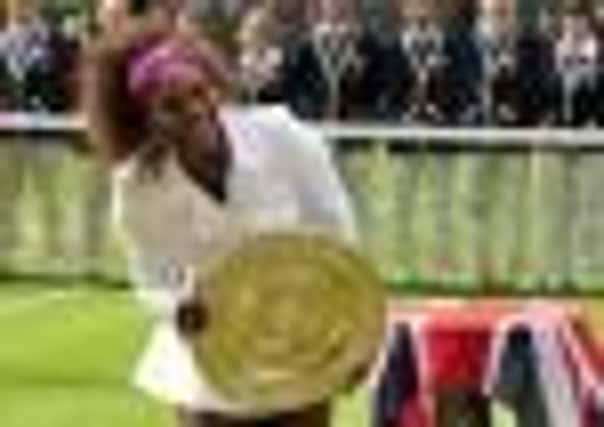Wimbledon: Two sides of Serena Williams on show


Both sides of the American’s character were on display yesterday in the 6-1, 5-7, 6-2 victory over Agnieszka Radwanska which gave her her fifth Wimbledon singles title and 14th individual Grand Slam over all. The first set was embarrassingly one-sided, even more so than the score would suggest. But after a short rain break, the Pole came into her own, and mounted a spirited fightback against her clearly superior opponent.
The omens had not been good for Radwanska. You need to be at your best to have a chance against Williams, and she was not. She had withdrawn from the doubles with younger sister Urszula because of a respiratory infection, and the same complaint forced her to cut back on media duties on the eve of the final.
Advertisement
Hide AdAdvertisement
Hide AdIndeed, for a time on Friday there were rumours here that Radwanska might not even be able to compete in the final. Her coach quashed those rumours later that day, but these were still less than ideal circumstances in which to compete – especially as this was completely new territory for Radwanska, who had never previously made it as far as a semi-final in one of the four major tournaments.


The No.3 seed’s victory over Angelique Kerber in that last-four clash had members of the media playing a version of the ‘Name five famous Belgians’ game as they asked themselves if Radwanska had just become the greatest sporting Pole ever. Some of us argued that Bronislaw Malinowski, the 1980 Olympic gold medallist in the 3,000 metres steeplechase, had a greater claim to fame, although we may have been a little biased by the fact that the athlete’s mother was from Musselburgh.
But while such debates are always subjective, there was one undeniable fact about Radwanska. If she beat Williams, she would become world No.1 for the first time.
During the first set, that very possibility only seemed to highlight the lack of depth in the women’s game at present. How could someone who was being so hopelessly outclassed have approached so near to the summit?
There are two separate answers to that question. One is that on her day, when she is fit and on form, Radwanska is a fine player: there is a metronomic quality to her strokes, a relentless reliability that is usually enough to see off those many opponents who lack that consistency.
The other answer is that for some years now the world No.1 ranking has been a misnomer. No matter whether it was held by Dinara Safina or Ana Ivanovic, Jelena Jankovic or Victoria Azarenka, the reality is that Serena Williams remains the best player on the planet. The injury and illness which forced her out of the sport for the best part of a year from mid-2010 may have persuaded some people otherwise, but over the past fortnight the 30-year-old has again proven that her brutal power is by some way superior to her would-be rivals’.
That power has been most evident here in her serve. She set a record of 23 aces in an early round, bettered it with 24 in her semi with Azarenka, and started off in similar vein against Radwanska.
The first set was essentially over after the second game, in which the Pole battled on through five deuces until eventually being broken. After that, the only real question was whether we would see a player lose the first set without winning a game for the first time since 1983, when Andrea Jaeger went down 6-0, 6-3 to Martina Navratilova. The Wimbledon crowd, supportive as ever towards the plucky underdog, willed Radwanska to avoid that humiliating defeat, and in the end she just made it. Serving at 0-5, she had to save two set points before eventually getting off the mark.
Advertisement
Hide AdAdvertisement
Hide Ad“Aggie! Aggie! Aggie!” an enthusiast chanted, but no one chanted “Oi! Oi! Oi!” in return. That would have been taking sympathy too far.
Nonetheless, it was understandable that those who had paid over £100 a ticket were harbouring hopes of some sort of contest. When Williams wrapped up the set it looked unlikely they would get one, but that changed after a 25-minute rain break.
Radwanska came out for the restart with a spring in her step,and although her serve was broken again in the third game, it was obvious that Williams’ concentration had been affected by the break. The American lost her own serve at 4-4, and from being on top of her game, now displayed the kind of nerves which had earlier bedevilled her younger opponent. Serving to force a tiebreak, Williams quickly put herself in trouble with a double fault, and then seemed to give up on the game.
The four-time champion went behind in the match for the first time when Radwanska held serve in the first match of the deciding set, and for a spell the prospect of an improbable upset began to suggest itself.
But then Williams, shrugging off the tightness that had got to her in the second set, reasserted herself. She broke Radwanska for a 3-2 lead, repeated the trick two games later, then clinched the championship on her first match point. Although nowhere close to being a classic, the match could have been a lot worse. And, for all that there was a certain inevitability about the outcome, there was also a sense of satisfaction that justice had been done. After two years without a major title, the queen was back on her throne.